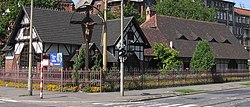Breslau-Trebnitz-Prausnitzer Kleinbahn
| Breslau – Trebnitz – Prausnitzer Kleinbahn | |||||||||||||||||||||||||||||||||||||||||||||||||||||||||||||||||||||||||||||||||||||||||||||||||||||||||||||||||||||||||||||||||||||||||||||||||||||||||
|---|---|---|---|---|---|---|---|---|---|---|---|---|---|---|---|---|---|---|---|---|---|---|---|---|---|---|---|---|---|---|---|---|---|---|---|---|---|---|---|---|---|---|---|---|---|---|---|---|---|---|---|---|---|---|---|---|---|---|---|---|---|---|---|---|---|---|---|---|---|---|---|---|---|---|---|---|---|---|---|---|---|---|---|---|---|---|---|---|---|---|---|---|---|---|---|---|---|---|---|---|---|---|---|---|---|---|---|---|---|---|---|---|---|---|---|---|---|---|---|---|---|---|---|---|---|---|---|---|---|---|---|---|---|---|---|---|---|---|---|---|---|---|---|---|---|---|---|---|---|---|---|---|---|
|
Former narrow-gauge railway station on Benderplatz in Wroclaw
(today Plac Stanisława Staszica ) | |||||||||||||||||||||||||||||||||||||||||||||||||||||||||||||||||||||||||||||||||||||||||||||||||||||||||||||||||||||||||||||||||||||||||||||||||||||||||
| Route length: | 37.1 km | ||||||||||||||||||||||||||||||||||||||||||||||||||||||||||||||||||||||||||||||||||||||||||||||||||||||||||||||||||||||||||||||||||||||||||||||||||||||||
| Gauge : | 750 mm ( narrow gauge ) | ||||||||||||||||||||||||||||||||||||||||||||||||||||||||||||||||||||||||||||||||||||||||||||||||||||||||||||||||||||||||||||||||||||||||||||||||||||||||
Names up to 1945 in lower case behind it |
|||||||||||||||||||||||||||||||||||||||||||||||||||||||||||||||||||||||||||||||||||||||||||||||||||||||||||||||||||||||||||||||||||||||||||||||||||||||||
The Breslau-Trebnitz-Prausnitzer Kleinbahn AG operated a narrow-gauge railway that crossed the Trebnitz district in Silesia and was also known as the "Katzengebirgsbahn".
history
The Trebnitz district around the Katzengebirge north of Breslau initially only had rail connections in its eastern and western peripheral areas in the mid-19th century. It was not until the state railway line opened in 1886 from Breslau via Hundsfeld that it also reached the district town of Trebnitz with around 7,000 inhabitants. Nevertheless, the district residents wanted an additional connection to Breslau and a continuation in the neighboring district of Militsch.
The Allgemeine Deutsche Kleinbahn-Gesellschaft founded the Breslau-Trebnitz-Prausnitzer Kleinbahn AG on July 3, 1897 and, after the line was completed, transferred the management to its subsidiary, the Allgemeine Deutsche Eisenbahn-Betriebs-GmbH .
The small train, which was laid out in 750 mm narrow gauge, first began on July 1, 1898 in the town of Karlowitz, north of the Alte Oder, which was incorporated into Breslau in 1924 . It led in a northerly direction to the city of Trebnitz in the Katzengebirge. This 24-kilometer section was extended in October 1898 by 11 kilometers to the small town of Prausnitz in the Militsch district . In Wroclaw, the end point of the railway was moved 2 kilometers closer to the city center, with the regular-gauge tram running on a three- rail track in parts of the street and since 1903 in mixed operation . The two-track, three-rail section on the Gröschel Bridge and in Rosenthaler and Oswitzer Strasse was a total of 960 meters long. The new small station, which was put into operation on January 5, 1899, was in the Odervorstadt near the Odertor station, where the trains of the state railways to Trebnitz and Oels also departed. A connection to the Oderhafen was built south of the Gröschel Bridge.
After the Second World War , the small railway came under Polish administration. The stations were renamed accordingly, and the small station has been called Wrocław Wąskotorowy since then . In addition, the now nationalized railway was operationally combined with the Trachenberg-Militscher Kreisbahn to form Wrocławska Kolej Dojazdowa (Wroclaw suburban railway). On December 15, 1951, traffic was withdrawn from the Odervorstadt by structurally adapting the former narrow-gauge freight station on the northern bank of the Alte Oder (Polinkeweg) for passenger handling and closing the section south of it, including the station at Benderplatz, as it was an obstacle for road traffic. At the former freight yard, which was now called Wrocław Wąskotorowy , there was an opportunity to change to the city tram. The operation on the section between Breslau (former freight yard) and Trebnitz was stopped on May 27, 1967; then the tracks were dismantled. The last section between Trebnitz Stadtpark (Trzebnica Gaj) and Prausnitz was used regularly until September 14, 1991.
Timetable
While the state railway reached the district town in an hour, the small railway initially needed twice the travel time. In Trebnitz the small train stopped about 400 meters east of the state train station at the Hedwigsbad stop and then continued to the Stadtpark small train station in the north of the city, the center of operations with the workshop.
The timetable from summer 1914 contained two trains on weekdays from Breslau to Prausnitz, three to Trebnitz and four to Hochkirch; On Sundays there were additional trains, especially for day trippers to Hedwigsbad and pilgrims to the grave of St. Hedwig . The state railway used eight trains a day to Trebnitz. In the summer of 1944, four trains were planned for Trebnitz, plus one on weekdays to Hochkirch. The Reichsbahn then subsided Trebnitz seven weekdays and Sundays operate six trains that started already at the Wroclaw central station since the 1920s. Between Trebnitz and Prausnitz three pairs of trains drove the Kleinbahn. A further journey on the Trachenberg-Militscher Kreisbahn to Trachenberg was only possible once a day in 1914, and later only on Wednesdays and Saturdays until around 1939. After that, no more people were transported there.
The following vehicles were available in 1939: 8 steam locomotives, 34 passenger cars, 3 pack wagons and 146 freight cars; also roller stands, with which standard-gauge freight cars were transported to Hochkirch.
After the merger of the railway with the Trachenberg-Militscher Kreisbahn in 1945 under Polish direction, there were again continuous trains to Trachenberg (Polish Żmigród ) and even to Sulmirschütz (Sulmierzyce) . While in 1944 a passenger train pulled by a steam locomotive between Breslau Kleinbahnhof and Trebnitz Stadtpark took 1 hour and 45 minutes, after the complete introduction of the diesel multiple unit in the 1950s, the travel time was reduced considerably to around an hour. However, the railways now ended north of the Gröschel Bridge (Most Osobowicki) . The timetables also show that the trains no longer stopped in Breslau-Karlowitz, Breslau-Lilienthal and Hünern. In the 1960s, the travel time increased again to around 90 minutes.
literature
- Siegfried Bufe: Railways in Silesia . Bufe-Fachbuch-Verlag, Egglham u. a. 1989, ISBN 3-922138-37-3 ( East German Railway History 4).


